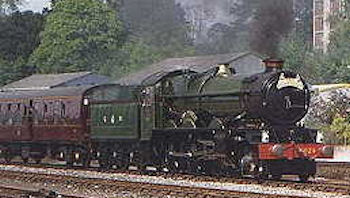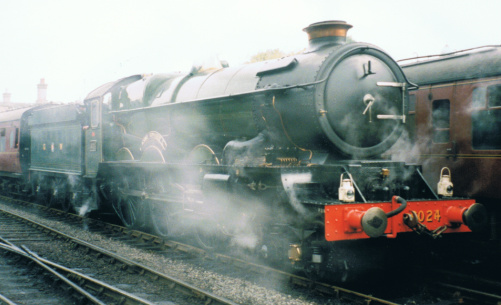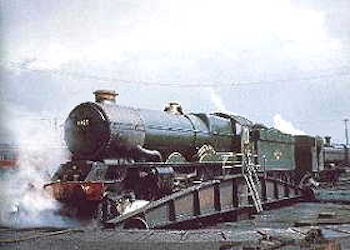
|
|
|
6000 'King' class introduction
Running numbers 6000 to 6029.
Built 1927-28 (6000 - 6019) to lot number 243,
1930 (6020 - 6029) to lot number 267,
1936 (replacement 6007) to lot number 309.
The English may have had a King Edgar, but regrettably they never had a King Elgar, which was pity as it would have been fitting name for one of the ultimate Great Western express engines. The bark of a 'King' on Hemerdon Bank had more than a whiff of 'Land of Hope and Glory' about it; this was apt for South Devon was, and still is, a land of glory and any train tackling the 1 in 40 from Plympton to Hemerdon had to have a fair degree of hope as well.
When the 'Kings' were first built in 1927, the Paddington publicity department made the most of their visible power - the highest tractive effort in the country and the longest non-stop run in the country (London to Plymouth). The Caledonian had been criticised for appropriating the Royal Arms of Scotland, much to annoyance of the North British Railway who  no doubt would have done so had they thought of it first. Paddington simply looked up Holinshed's Chronicle and while the Great Western could get into a rut when naming engines, as with the 'Halls', the 'Kings' were few enough in number to avoid a similar trap. As it was, the King names were an inspired choice for such regal and dignified engines, redolent of power.
no doubt would have done so had they thought of it first. Paddington simply looked up Holinshed's Chronicle and while the Great Western could get into a rut when naming engines, as with the 'Halls', the 'Kings' were few enough in number to avoid a similar trap. As it was, the King names were an inspired choice for such regal and dignified engines, redolent of power.
Like all Great Western engines they were exceedingly photogenic on account of their clean, uncluttered, angular lines, and rivets which caught the light very effectively in a photo and seemed just a little bigger than anyone else's. With taper boilers, copper-capped chimneys and brass bonnet safety valve cover, the 'Kings' were pure GWR in line. Some critics looked at the 'Kings' as weight-pullers without the impression of speed that the 'Castles', 'Saints' and 'Stars' gave, while others suggested that the very big boiler and heavy front end would have looked better on a Pacific 4-6-2 chassis, but the ghost of The Great Bear still haunted the corridors of Swindon and Pacific was a dirty word.
With the design of the 'Kings', the concept of a big four-cylinder 4-6-0 had reached its zenith. MacIntosh found this with his big-boilered inside-cylinder locos culminating in the Cardean class - superb to look at, heavy on coal and incapable of further development. Certainly the 'Kings' were at the limit although modifications in the 1950s gave them a completely new lease of life and they staged a brilliant Indian summer with the end of steam on the Western.
The basic 'King' as built in 1927 carried a boiler pressure of 250 pounds per square inch, an advance of 25 pounds over Swindon's practice at the time, and had a driving wheel diameter of 6 feet 6 inches - a reduction of 2½ inches from the 6 feet 8½ inches standard for GWR express passenger engines. The valve gear was the standard Churchward adaptation of the Stephenson link motion set between the frames, with the outside cylinders worked by rocker arms. Careful attention was paid to free steam flow to and from the large 16¼ inch by 28 inch cylinders and, like the 'Castles', they had very long-lap valve travel. The 'Kings' were heavy engines with a 22½ ton axle loading and as a result their route availability, Double Red in GWR terms, was restricted: for instance, they were not allowed west of Plymouth, or north of Shrewsbury (in theory), or on the Oxford to Worcester route. On the other hand, their great attribute was their sure-footedness, probably the best this country has ever known and a fact vividly illustrated by the way number 6018 'King Henry VI' stalked through the tunnels out of Kings Cross in the 1948 Locomotive Exchanges. One visual difference of the 'Kings' to other GW locomotives was in the bogie design with outside bearings for the leading axle and inside bearings for trailing to give adequate clearance on curves.
attribute was their sure-footedness, probably the best this country has ever known and a fact vividly illustrated by the way number 6018 'King Henry VI' stalked through the tunnels out of Kings Cross in the 1948 Locomotive Exchanges. One visual difference of the 'Kings' to other GW locomotives was in the bogie design with outside bearings for the leading axle and inside bearings for trailing to give adequate clearance on curves.
The first 'King' locomotive, number 6000 King George V was completed in June 1927 and shortly afterwards it was shipped to America to participate in the Baltimore and Ohio Railroad centenary celebrations. There the engine was presented with a bell and plaques to commemorate its contribution and these are still carried by the locomotive today. When King George V returned to Britain it was affectionately know as 'The Bell' until its withdrawal.
The bulk of the 'Kings' work was done on the West of England main line between Paddington and Wolverhampton. Their great weight-pulling ability and good adhesion showed up best over the ferocious South Devon banks between Newton Abbot and Plymouth. Even here, a 'King' had to be piloted on the heavier trains and it was common for the pilot engine to be an elderly 4-4-0 of the Bulldog or Dukedog class. When coupled in front of a massive 'King', it gave the impression of a rabbit about to be caught by a very large dog! The 'Kings' proved very reliable in service in addition to being remarkably easy on coal. One feature that militated against an even better performance was Swindon's dislike of superheating, for as built, such large machines had a very low degree of superheat, remedied by experimenting with a four-row high-degree superheater in 1947 with 6022 King Edward III . Originally this was due to the lack of selected Welsh coal at the time; when Stanier moved to the LMS it did not take him long to find that with inferior coal increased superheating was essential - no matter how good the boiler and front-end design might be.
The 'Kings' had an excellent record of safe running,  marred only by the involvement of number 6007 King William III in the destructive accident at Shrivenham in January 1936 where the damage was so severe that a completely new replacement locomotive was built, and the unhappy incident at Norton Fitzwarren in 1940 in which number 6028 King George V was badly damaged.
marred only by the involvement of number 6007 King William III in the destructive accident at Shrivenham in January 1936 where the damage was so severe that a completely new replacement locomotive was built, and the unhappy incident at Norton Fitzwarren in 1940 in which number 6028 King George V was badly damaged.
After the war came nationalisation and the famous Locomotive Exchanges. Owing to their limited route availability and loading gauge restrictions, the only 'foreign' line that could take the 'Kings' was the Great Northern route from Kings Cross to Leeds. The 'King' was placed in the same class as the LMS 'Duchess', the LNER 'A4' and the SR 'Merchant Navy'. The 'King' did not show up particularly well on the LNER and at the time it was stressed that it was burning South Yorkshire coal. Despite this, again and again number 6018 demonstrated its ability to make clean fast starts from awkward places compared with the difficulties experienced by the Pacifics. The lesson of the 1948 Exchanges was not lost on Swindon, and the work on four-row superheaters was accelerated. In addition, modifications were also made to the draughting arrangement, initially using number 6001 King Edward VII as a test-bed. In July 1953 she worked a 796 ton train between Stoke Gifford and Reading at express speeds to evaluate the effectiveness of the new draughting arrangement. In fact, she covered the 73½ miles between these points in just under 77 minutes, maintaining 67 - 70 miles per hour on easier than level track. Yet more improvement came in September 1955 with the fitting of double blast-pipes and chimneys fitted firstly to number 6015 King Richard III . The whole of the class was then modified to encompass all of the improvements that had been found. Had the 'King' used in the Locomotive Exchanges been thus treated, the results might well have been vastly different, for in their last 10 years of use the 'Kings' went out in a blaze of glory.
One problem that affected the 'Kings' for a number of years were fatigue cracks on the front bogie frames. Normally repairs were made by simply welding over the cracks, however by January 1956 the cracks became sufficiently numerous that the whole class had to be temporarily withdrawn until stiffening strips were fitted to the bogie frames.
The class was extinguished during 1962 but never suffered the indignity of relegation to menial jobs. But the Great Western has always managed to have the last word and it was appropriate that 'King' number 6000 began the return to steam on British Rail metals in 1971. Working out of Swindon on the final leg of a round tour with the Bulmer's Pullman train that October, King George V rather grandly passed the ranks of condemned diesel-hydraulics on the Works 'dump' and it was strange to reflect that the 'Kings' replacements had lasted less than a third of number 6000's working life of 35 years. Two other 'Kings' were saved from the cutters torch, numbers 6023 King Edward II and 6024 King Edward I .
Specifications. Copyright © by John Daniel 2013.
Cylinders
(4) 16¼ x 28 inches
Driving wheel diameter
6 feet 6 inches
Bogie wheel diameter
3 feet 0 inches
Tractive Effort
40,300 pounds
Boiler type
Number 12
Boiler maximum dia.
6 feet 0 inches
Boiler minimum dia.
5 feet 6¼ inches
Fire tubes, no. and dia.
171 x 2¼ inches
Flue tubes, no. and dia.
16 x 5 7/8 inches
Superheater tubes, no. and dia.
96 x 1 inch
Boiler pressure
250 lbs/square inch.
Boiler length
16 feet 0 inches
Area of firegrate
34.3 square feet
Heating surfaces, tubes
2,008 square feet
Heating surfaces, firebox
194 square feet
Heating surfaces, superheater
313 square feet
Length
68 ft 2 in
Total Weight
135 tons 14 cwt
Water Capacity
4000 gallons
Coal Capacity
6 tons
G.W. Power Class
Special
Route Availability
Double Red
BR Power Classification
8-P
